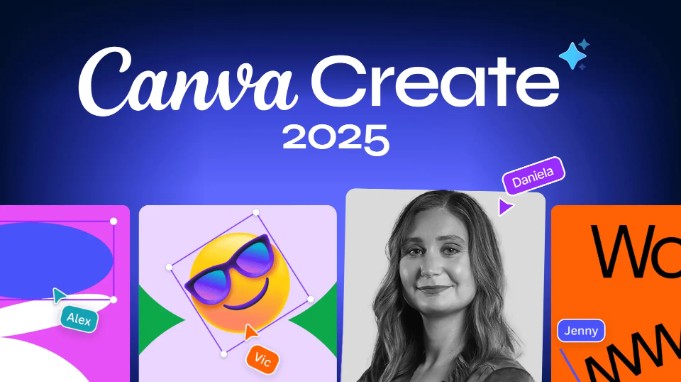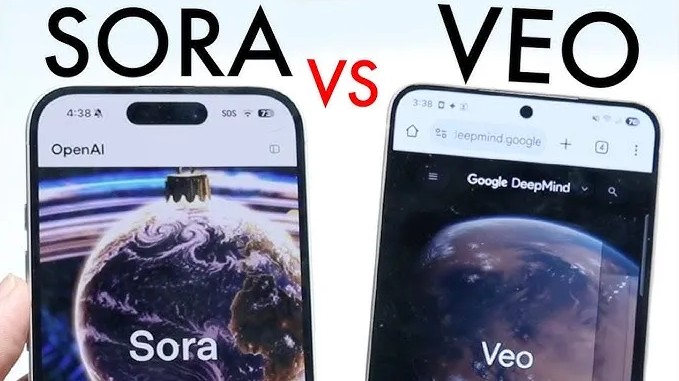Best Selling Products
Canva Create 2025: Tech Boost or Creative Identity Threat?
Nội dung
- 1. Canva innovates based on the increasingly diverse design needs of users
- 2. Canva Create 2025: A Complete Overhaul and a Vision Beyond Design
- 2.1. Visual Suite 2.0: Seamless creative environment, comprehensive collaboration
- 2.2. Canva Sheets: Next-generation spreadsheets with integrated AI
- 2.3. Canva Code: When programmers are also part of the Canva ecosystem
- 3. The AI Debate: Opportunity or Danger for Creators?
- 3.1. AI is thriving – Opportunity or threat?
- 3.2. Canva responds: AI is a support tool, not a competitor
- 3.3. How should creative people adapt?
The Canva Create 2025 event introduced a series of upgrades and new features, which the company described as its biggest step forward yet. The goal this time was not just to “improve the interface” or “optimize the user experience,” but to build a seamless creative collaboration platform.

In the rapidly growing digital creative era, Canva, a design platform once known as “Photoshop for non-designers,” has once again caught the attention of the technology world when it announced a comprehensive update at the Canva Create 2025 event . This is not simply a feature upgrade, but a strategic milestone, marking the evolution from a personal tool to a powerful integrated creative ecosystem for businesses, marketers, and programmers.
However, behind the remarkable improvements, the praise for AI and the seamless working experience, the creative community has also begun to have many big questions: Is AI "stealing" the role of humans? Where is the boundary between manual creation and machine creation? Let's join SaDesign to analyze in detail what Canva has just announced and the ongoing debates surrounding the update considered the biggest since 2012.
1. Canva innovates based on the increasingly diverse design needs of users
A few years ago, Canva made a breakthrough with the launch of Visual Suite 2022, laying the foundation for expanding its audience from individual content creators to medium and large businesses. Since then, the platform has continued to evolve to serve a wider range of users with more diverse design needs than ever before.
In March 2025 alone, global users created over 1 billion designs, which equates to over 420 designs per second, a number that shows Canva’s continued expansion. Since its inception in 2013, over 34 billion designs have been created on the platform, a clear testament to its phenomenal growth.
.png)
Despite facing criticism for raising the price of its Canva Pro package in 2024, the company has still recorded success beyond expectations, attracting 50 million new users in just one year, bringing the total number of users to 230 million, while achieving a revenue of $3 billion per year.
A survey conducted by Canva in collaboration with MMA Global with chief marketing officers (CMOs) also showed that 77% of CMOs believe that investing in creativity has never been more important than it is now. This further reinforces Canva's development direction, not only stopping at design software but also aiming to become a comprehensive digital creative infrastructure. The company also does not hide its ambition to reach 1 billion monthly active users, equivalent to about 1/5 of the global internet population.
2. Canva Create 2025: A Complete Overhaul and a Vision Beyond Design
The Canva Create 2025 event introduced a series of upgrades and new features, which the company described as its biggest ever. The goal this time was not just to “improve the interface” or “optimize the user experience,” but to build a creative collaboration platform that spans design, spreadsheets, presentations, and programming.
Canva makes no secret of its ambition to compete with platforms like Microsoft Teams, Notion, Excel, and even Adobe Creative Cloud. The tools it announced are not only aimed at creatives, but also clearly serve businesses, marketing departments, and programmers.
2.1. Visual Suite 2.0: Seamless creative environment, comprehensive collaboration
At the heart of this update is Visual Suite 2.0, a comprehensive redesign of the toolset aimed at eliminating the boundaries between design types.
.jpg)
Previously, users had to choose the right type of document to create such as slides, prints, websites, etc. Now, with AI support, Canva allows seamless creation and editing on all formats, in the same workspace similar to the collaboration model of Google Docs but for all creative content.
What's special is that all content can be manipulated simultaneously by multiple members, in real time, helping creative, marketing or content production teams easily "stay on the same page", no matter where they are working.
.png)
Melanie Perkins, Co-founder of Canva, shares:
“The new interface not only connects the creative and consumer processes, but also unifies context and communication. Now each department no longer needs to work on separate tools, everything is integrated in a single space.”
2.2. Canva Sheets: Next-generation spreadsheets with integrated AI
One of the surprise highlights of Canva Create 2025 was the launch of Canva Sheets, a smart spreadsheet powered by artificial intelligence. This is not just a “beautified Google Sheets” but a completely new tool designed by Canva to make data more understandable, visual, and aesthetically pleasing.
.png)
Some outstanding features:
Magic Insights and Magic Formulas: Allows users to use natural language to create formulas or data queries. For example: “List restaurants in Milwaukee with food emojis”, Canva will automatically generate a complete table.
Magic Charts: Connect data from platforms like Salesforce, Google Analytics, HubSpot,… to create beautiful charts.
Insert images directly into spreadsheet cells – something that traditional Excel or Sheets don't support.
Bulk content translation: Users can enter content in each cell and translate the entire thing with just one click, extremely convenient for international campaigns.
This is a clear demonstration of Canva's expansion beyond the realm of "graphic design" to become a comprehensive business support platform.
2.3. Canva Code: When programmers are also part of the Canva ecosystem
Not stopping there, Canva also attracted the attention of the programming community when launching Canva Code, an interactive programming tool powered by AI.
.png)
Inspired by products like Google's Gemini Code Assist or GitHub Copilot, Canva Code allows users to:
Enter requests in natural language,
And the system will automatically generate the appropriate code, which can be embedded directly into the design.
While Canva Code can’t yet build a full app, it’s an important step in moving from static designs to interactive content. It also opens up opportunities for developers to collaborate more closely with creatives, rather than working on separate tools.
3. The AI Debate: Opportunity or Danger for Creators?
Alongside the applause at Canva Create 2025, the event also sparked a big debate in the creative community: Is AI assisting or gradually replacing humans?
3.1. AI is thriving – Opportunity or threat?
More and more platforms like Canva, Adobe, Figma are integrating AI to speed up design and automate processes, allowing users to create products faster and easier. However, many creators are concerned that their personal identity and creativity could be “stolen”.
(1).png)
Some AI models are trained on massive data sets that include the work of millions of artists without their consent or attribution, raising concerns that AI technology is obscuring the value of individuality in design.
“AI technology should not be an excuse to overshadow copyright and creative personality,” – one designer shared on Behance.
Additionally, AI's ability to create "averaged" versions of designs from learning data has many worried about a future where design becomes homogeneous and emotionless.
3.2. Canva responds: AI is a support tool, not a competitor
In response to these concerns, Canva asserts that AI only plays a role in supporting users to create faster and collaborate more effectively, not replacing humans.
.png)
“This is not a battle between AI and humans. AI opens a new chapter for faster, better, and more engaging creativity,” said Cameron Adams, co-founder of Canva.
Canva is also committed to being more transparent about protecting user data, allowing it to opt out of sharing designs to train AI similar to what Adobe is doing.
3.3. How should creative people adapt?
Instead of being fearful, the creative community should proactively embrace AI and use it as a tool. Some smart approaches include:
Develop a distinct personal style that is difficult to copy mechanically.
Understand AI to exploit it effectively, especially in repetitive tasks.
Protect intellectual property with watermarks, transparent platforms, and content verification tools.
In a world where AI is evolving every day, creatives need to maintain their identity while adapting flexibly to avoid being left behind.
The big update at Canva Create 2025 is more than just a redesign or a few new features. It’s a manifesto for a new era in digital creativity, where technology, especially artificial intelligence, plays a key role in the design, collaboration, and product development process.
While there are still many debates and challenges, one thing is certain: Canva is constantly moving forward and creatives, whether designers, marketers or coders, need to learn how to adapt, leverage and collaborate with AI, so as not to be left behind in the digital creative era.












































